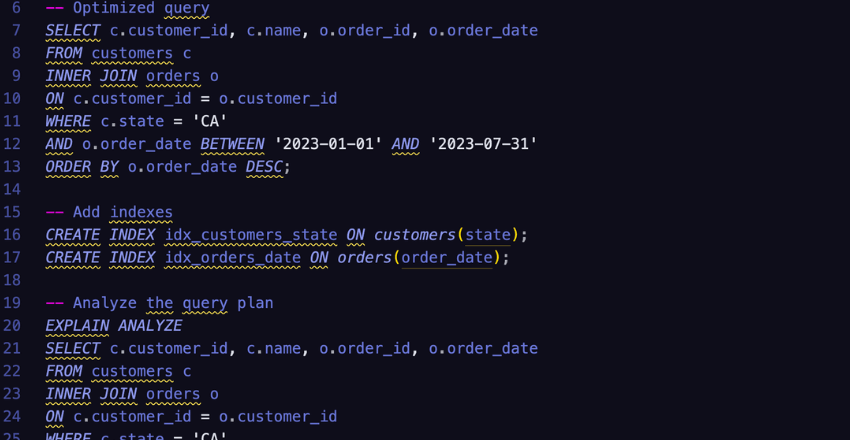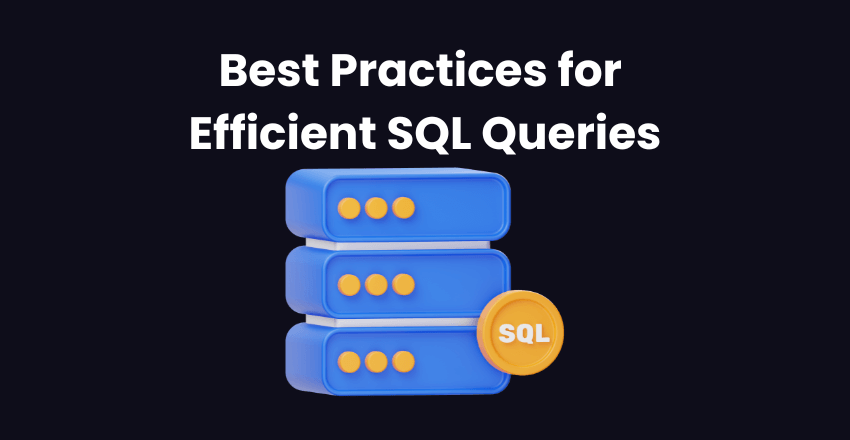
SQL Query Optimization improves performance through indexing, partitioning, and reformulating queries.
SQL query performance is a critical component of database management. Poorly performing queries can lead to slow response times, high CPU usage, and degraded overall system performance. This is where SQL query optimization comes into play. By optimizing queries, we can improve their performance, resulting in faster execution times and more efficient use of system resources.
Key Takeaways:
- SQL query optimization is essential for improving database performance.
- Poorly performing queries can lead to slow response times and high CPU usage.
- Optimizing queries can result in faster execution times and more efficient use of resources.
Understanding SQL Query Performance Issues
One of the most important aspects of optimizing SQL queries is understanding the common performance issues that can arise. Query performance can be impacted by a variety of factors, including slow response times, high CPU usage, and inefficient data retrieval.
Slow response times can occur when queries are poorly designed or when indexes are missing. High CPU usage can occur when queries are executed too frequently, or when complex queries are run on large datasets. Inefficient data retrieval can occur when queries require too much data to be transferred over the network.
It is essential to address these issues through SQL query optimization in order to improve database performance. By optimizing SQL queries, response times can be improved, resource usage can be reduced, and data retrieval can be made more efficient.
Common Causes of Query Performance Issues
There are several common causes of query performance issues:
| Cause | Description |
|---|---|
| Missing indexes | Queries that rely on non-existent or poorly designed indexes can result in slow query performance. |
| Complex queries | Large, complex queries can consume significant resources and slow down performance. |
| Unoptimized joins | Join operations can be resource-intensive, and unoptimized joins can lead to poor query performance. |
| Network overhead | Transferring large amounts of data over the network can lead to slow query performance. |
It is important to identify and address these issues through SQL query optimization to achieve optimal database performance.
Techniques for Optimizing SQL Queries
SQL query optimization is an essential process for improving database performance. Here are some optimization tips and best practices for optimizing SQL queries:
1. Indexing
Indexes are crucial for optimizing SQL queries. They act as pointers to the data stored in the table and help to speed up data retrieval. It is recommended to create indexes on columns that are frequently used in WHERE, JOIN, and ORDER BY clauses. However, too many indexes can also slow down the performance, so it is important to strike the right balance when selecting columns for indexing.
2. Query Rewriting
Query rewriting involves modifying the SQL query to make it more efficient. This can be done by breaking down complex queries into simpler ones or using subqueries instead of joins. By rewriting queries, you can improve the execution plan and reduce the query response time.
3. Join Optimization
Join operations can be a major bottleneck in SQL query performance. To optimize joins, it is important to choose the right join type and join algorithm. Avoid using cross joins and use appropriate join hints to guide the query optimizer. You can also improve join performance by denormalizing the database schema or creating covering indexes.
4. Efficient Use of Joins
Another tip for optimizing SQL queries is to use joins efficiently. Minimize the number of joins required by carefully selecting the columns to retrieve, using WHERE clauses to filter data, and selecting the right join type. It is also important to avoid using subqueries extensively, as they can slow down the query performance.
5. Performance Monitoring and Tuning
Regular monitoring of the SQL query performance is essential for identifying and resolving performance issues. Use SQL profiling tools to analyze the query statistics and identify slow-running queries. Implement caching mechanisms, such as query caching or result set caching, to reduce the query response time. Tune the database server and allocate sufficient hardware resources to improve the overall performance.
By following these optimization tips and best practices, you can significantly improve the performance of your SQL queries and enhance the overall database performance.
Analyzing Query Execution Plans

Query execution plans are essential for optimizing SQL queries. They provide a detailed roadmap of how the database engine will execute a query and the resources required.
To analyze a query execution plan, you need to understand the basic elements of the plan. Here are the essential parts of a query execution plan:
| Element | Description |
|---|---|
| Operators | These are the building blocks of the plan. They represent the physical operations that the database engine performs, such as table scans, index seeks, and joins. |
| Estimates | These are the estimated number of rows and the estimated cost of each operator. They help you understand the relative impact of each operator on the query performance. |
| Actuals | These are the actual number of rows and the actual cost of each operator. They provide feedback on the accuracy of the estimates and help you identify any discrepancies. |
| Execution order | This is the order in which the database engine executes the operators. It is essential to understand the execution order to identify any bottlenecks and potential optimization opportunities. |
Once you have a basic understanding of query execution plans, you can use them to optimize SQL queries. Here are some tips:
- Avoid using table scans: Table scans are the most expensive operators in a query execution plan. Try to use indexes or other optimization techniques to avoid them.
- Use index seeks: Index seeks are more efficient than table scans for retrieving data. Use them whenever possible.
- Minimize joins: Joins are expensive, especially if they involve large tables. Try to minimize the number of joins and the size of the tables involved.
- Avoid sorting: Sorting can be expensive, especially if it involves large amounts of data. Try to avoid sorting whenever possible.
- Use query hints: Query hints can be a powerful tool for optimizing SQL queries. They allow you to influence the query execution plan and force the database engine to use specific optimization techniques.
Here’s an SQL code example that illustrates how to analyze a query execution plan:
EXPLAIN SELECT * FROM customers WHERE age > 30;
This code will generate a query execution plan for the SELECT statement and show you the operators, estimates, actuals, and execution order.
By analyzing the query execution plan, you can identify potential optimization opportunities and improve the performance of your SQL queries.
Indexing Strategies for Improved Performance
One of the most important factors affecting SQL query performance is indexing. Properly indexing your database can lead to significant improvements in query performance. There are several types of indexes, including clustered and non-clustered indexes, and each has its own advantages and disadvantages.
Clustered indexes determine the physical order of data in a table based on the values in one or more columns. This can lead to faster retrieval times for sorted data, but can also slow down insert and update operations.
Non-clustered indexes create a separate data structure that includes the indexed columns, allowing for faster retrieval times without affecting the physical order of the data. These can be particularly useful for columns with high selectivity, or those that are frequently used in WHERE or JOIN clauses.
When selecting columns for indexing, it is important to consider the selectivity of the column, as well as its cardinality. Columns with high selectivity (i.e. many distinct values) are typically good candidates for indexing, while those with low selectivity (i.e. few distinct values) may not benefit from indexing.
It is also important to regularly maintain your indexes to ensure optimal performance. This includes rebuilding or reorganizing indexes when they become fragmented, or removing unnecessary indexes that are not being used.
Considerations for Index Selection
When selecting columns for indexing, it is important to consider the following:
- Selectivity of the column
- Cardinality of the column
- Frequency of queries on the column
- Join and WHERE clauses that reference the column
It is also important to periodically review and optimize your indexing strategies as your data and query patterns change. This can help ensure that your database is running as efficiently as possible.
Here’s an example of how to create a non-clustered index on a column in SQL:
CREATE NONCLUSTERED INDEX idx_customer_name ON customers (customer_name);
Optimizing Joins for Faster Results

Joins are an essential feature of SQL queries, as they allow you to combine data from multiple tables. However, poorly optimized joins can cause performance issues, such as slow query execution times and excessive resource usage. In this section, we will explore some optimization tips for joins to help you achieve faster results.
Understand Join Types and Algorithms
First and foremost, it is crucial to understand the different join types and algorithms available. The most common join types are inner join, outer join, and cross join. The choice of join type depends on the data you are working with and the desired result.
The most efficient join algorithm is generally the hash join algorithm. However, this algorithm may not be suitable for all types of joins, such as joins with large data sets or complex conditions. It is essential to experiment with different join types and algorithms to find the optimal solution for your specific scenario.
Use Indexes for Join Columns
Using indexes on join columns can significantly enhance the join performance. When you join tables based on a column, ensure that this column is indexed. This enables the database engine to locate the matching rows more quickly, reducing the time needed for the join operation.
When using multi-column joins, it is essential to create composite indexes that include all the columns involved in the join. This can further reduce the join time and improve overall performance.
Avoid Joining on Large DataSets
Avoid performing joins on large datasets whenever possible. Large joins can be resource-intensive and can slow down query execution times. If possible, try to filter the data before joining to reduce the size of the result set.
Another option is to perform joins on smaller subsets of data by using subqueries or temporary tables. This can significantly improve join performance and reduce resource usage.
Use Join Conditions Effectively
The join condition is an essential component of the join operation. It determines the relationship between the tables and the data to be retrieved. It is essential to use join conditions effectively to improve performance.
Ensure that the join condition is as simple as possible and uses indexed columns where possible. Avoid using complex expressions or functions in the join condition as this can slow down the operation.
Additionally, use the appropriate join type based on the join condition. For example, if you are looking for non-matching records, use an outer join instead of an inner join.
Here is an example of an optimized join query:
SELECT orders.order_id, customers.customer_name, order_details.quantity FROM orders INNER JOIN customers ON orders.customer_id = customers.customer_id INNER JOIN order_details ON orders.order_id = order_details.order_id WHERE customers.city = 'New York'
In this example, the join condition uses indexed columns, and the query is filtered based on a specific city, reducing the size of the result set.
Optimizing joins is a critical aspect of SQL query optimization. By understanding join types and algorithms, using indexes appropriately, avoiding large data sets, and using effective join conditions, you can significantly improve query performance. Experiment with different optimization techniques and measure the results to find the optimal solution for your specific scenario.
Query Rewriting for Enhanced Performance

Query rewriting is a technique that involves modifying SQL queries to improve their performance. By changing the way a query is written, we can often improve the way it is executed by the database engine. Here are some tips for effective query rewriting:
- Simplify complex queries: Queries that contain complex subqueries or nested joins can often be simplified, which can result in faster query execution times.
- Avoid using correlated subqueries: Correlated subqueries can be slow and inefficient. Instead, try to rewrite these queries as joins or use temporary tables.
- Use EXISTS instead of IN: When checking for the existence of a value in a table, the EXISTS operator is often faster than the IN operator.
- Use UNION instead of OR: When combining the results of two queries, the UNION operator is often faster than using the OR operator.
Here is an example of query rewriting:
Original query:
Customer ID Order Date Product ID Quantity 123 2020-01-01 456 2 456 2020-01-02 789 1 SELECT * FROM orders WHERE customer_id IN ( SELECT customer_id FROM orders WHERE order_date >= '2020-01-01' ) AND product_id = 456;Rewritten query:
SELECT * FROM orders o1 WHERE EXISTS ( SELECT 1 FROM orders o2 WHERE o1.customer_id = o2.customer_id AND o2.order_date >= '2020-01-01' ) AND o1.product_id = 456;
In this example, the original query uses a subquery with an IN operator, which can be slow on large datasets. The rewritten query uses EXISTS instead, which can be faster.
Performance Monitoring and Tuning
Optimizing SQL queries is a continuous process that requires ongoing monitoring and tuning. Here are some optimization tips to help you improve your SQL query performance:
- Use SQL profiling tools: Profiling tools can help you identify slow or resource-intensive queries. You can then optimize these queries by identifying the bottlenecks and addressing them appropriately.
- Analyze query statistics: Analyzing query statistics can help you understand query performance. You can use this information to optimize queries by re-writing or restructuring them.
- Implement caching mechanisms: Caching frequently accessed data can help reduce the number of trips to the database, which can lead to improved performance.
By implementing these optimization tips, you can improve the performance of your SQL queries and enhance the overall performance of your database.
Best Practices for Efficient SQL Queries

Writing efficient SQL queries requires attention to detail and adherence to best practices. Here are some optimization tips to ensure your queries are performing at their best:
- Minimize data retrieval: Only retrieve the columns of data that are needed, rather than selecting all columns. This reduces overhead and can speed up query execution time.
- Use appropriate data types: Choosing appropriate data types can increase efficiency and reduce storage requirements. Avoid using generic data types such as varchar(max) when a more specific data type is available.
- Avoid unnecessary functions: Using functions such as CONVERT or DATEPART can negatively impact query performance. If possible, perform calculations or manipulations on the application side rather than in the query.
- Reduce network overhead: Minimize the amount of data transferred between the application and database server by using paging or limiting the number of rows returned.
Implementing these best practices can result in significant performance improvement for your SQL queries.
In addition, consider the following tips:
- Use comments to explain query logic: Adding comments to your queries can make it easier for other developers to understand and modify the queries.
- Use stored procedures: Stored procedures can improve performance by reducing network traffic and precompiling query execution plans.
Keep in mind that best practices may vary depending on the specific database and application requirements. Continual testing and benchmarking can help identify areas for improvement and refine optimization strategies.
Here’s an example of a query that adheres to best practices:
SELECT id, name, email FROM users WHERE status = 'active' ORDER BY name ASC OFFSET 0 ROWS FETCH NEXT 10 ROWS ONLY
This query only selects the necessary columns, filters by a specific status, orders by name in ascending order, and limits the results to the first 10 rows.
Testing and Benchmarking SQL Query Performance
Testing and benchmarking SQL query performance is crucial for identifying bottlenecks and improving query efficiency. Here are some optimization tips to help you test and benchmark your SQL queries:
- Create test scenarios: Develop test scenarios that simulate real-world situations to ensure you’re testing queries under realistic scenarios.
- Measure query execution time: Use SQL profiling tools to measure the execution time of your SQL queries. This will give you insights into which queries are taking the longest time to execute and where you need to focus your optimization efforts.
- Compare performance benchmarks: After making changes to your queries, benchmark their performance against the original query to see how they compare. This will help you determine if your optimization techniques are effective.
Testing and benchmarking SQL queries can be complex, particularly for large datasets. However, by following these optimization tips, you can identify performance issues and improve query efficiency to ensure your databases are running smoothly.
If you’re looking for an example of how to benchmark SQL queries, consider using the following code:
SELECT benchmark(1000000, (SELECT * FROM some_table))
This code will run a benchmark test on the “some_table” query and measure the time it takes to execute 1,000,000 times. This can help you identify performance issues and verify the effectiveness of any optimization techniques you’ve implemented.
Conclusion
SQL query optimization is crucial for improving database performance and ensuring efficient data retrieval. By following the techniques and best practices discussed in this article, you can optimize your SQL queries and achieve faster results.
To recap, understanding query performance issues, analyzing query execution plans, implementing indexing strategies, optimizing joins, query rewriting, performance monitoring, following best practices, and testing and benchmarking are essential for efficient SQL queries.
At HireSQL, we offer dedicated SQL developers who can help you optimize your queries and improve database performance. Contact us to learn more about our services and how we can assist you in achieving your business goals.
FAQ

Q: What is SQL query optimization?
A: SQL query optimization is a process of improving the performance of SQL queries by optimizing their execution plans. It involves identifying and resolving performance issues, such as slow response time and high CPU usage, to ensure efficient data retrieval from a database.
Q: Why is SQL query optimization important?
A: SQL query optimization is important because it can significantly improve database performance. Optimized queries result in faster response times, reduced resource usage, and improved scalability. This leads to better overall system performance, user experience, and cost-efficiency.
Q: What are some techniques for optimizing SQL queries?
A: Some techniques for optimizing SQL queries include indexing, query rewriting, query tuning, and efficient use of joins. These techniques involve optimizing the query structure, utilizing appropriate indexes, and improving the query execution plan to enhance performance.
Q: How can I analyze query execution plans?
A: You can analyze query execution plans by using tools like EXPLAIN or the Query Execution Plan visualizer in your database management system. These plans provide insights into the steps performed by the database engine during query execution, helping you identify bottlenecks and optimize query performance.
Q: What is the role of indexing in SQL query optimization?
A: Indexing plays a crucial role in SQL query optimization. Indexes are data structures that allow for faster data retrieval by enabling the database engine to locate specific data quickly. By properly utilizing indexes, you can significantly improve query performance and reduce the need for full table scans.
Q: How can I optimize join operations in SQL queries?
A: You can optimize join operations in SQL queries by considering factors such as join types, join algorithms, and join order. Techniques like using appropriate join types, optimizing join conditions, or restructuring the query can help improve join performance and overall query execution time.
Q: What is query rewriting and how does it improve performance?
A: Query rewriting is a technique where you modify an SQL query to achieve a more efficient execution plan. By rewriting queries, you can eliminate unnecessary or redundant operations, optimize data retrieval, and improve overall query performance. Query rewriting can lead to faster execution and reduced resource consumption.
Q: How can I monitor and tune SQL query performance?
A: Monitoring and tuning SQL query performance can be done by using SQL profiling tools, analyzing query statistics, and implementing caching mechanisms. By monitoring performance metrics, identifying bottlenecks, and implementing appropriate optimization strategies, you can optimize query performance and enhance database efficiency.
Q: What are some best practices for writing efficient SQL queries?
A: Some best practices for writing efficient SQL queries include minimizing data retrieval, using appropriate data types, avoiding unnecessary functions or subqueries, and reducing network overhead. By following these practices, you can optimize query performance and improve overall database efficiency.
Q: How do I test and benchmark SQL query performance?
A: To test and benchmark SQL query performance, you can create test scenarios, measure query execution time, and compare performance benchmarks. Tools like query profilers, benchmarking frameworks, and workload generators can assist in simulating real-world scenarios and evaluating query performance.
Q: What is the importance of SQL query optimization in query performance?
A: SQL query optimization plays a vital role in query performance as optimized queries result in faster response times, reduced resource usage, and improved scalability. By optimizing query execution plans, you can enhance database performance, user experience, and overall system efficiency.







